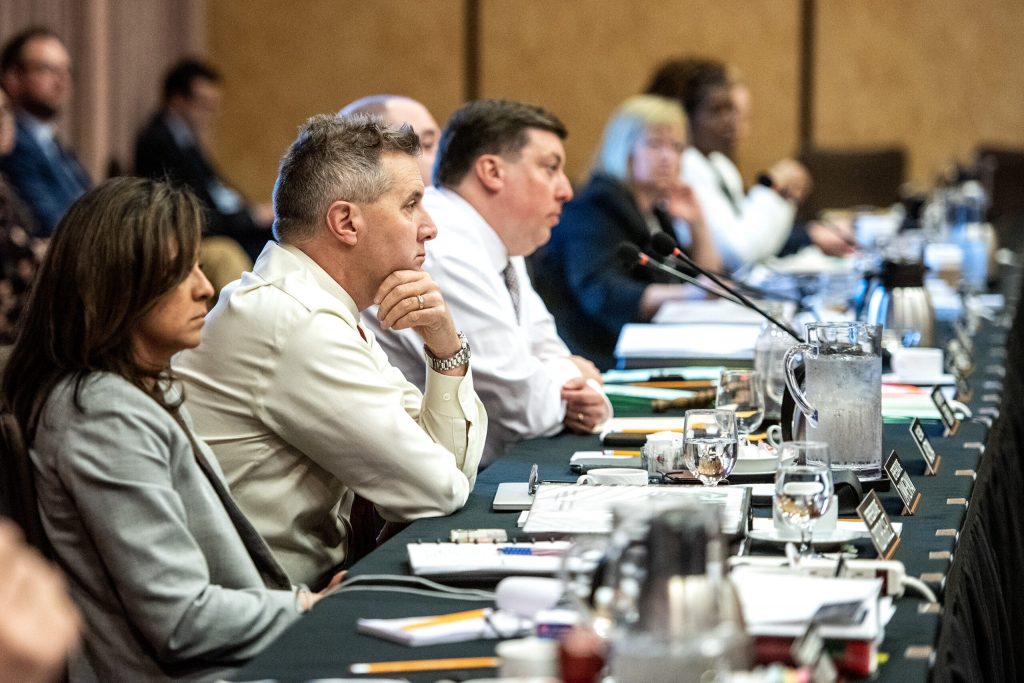Wisconsin Seeks To Match PFAS Rules To Federal Regulations
EPA set new standards for the forever chemicals in April.

Foam is seen at Olbrich Park in Madison, Wis., where PFAS-tainted Starkweather Creek enters Lake Monona. Public Health Madison and Dane County has warned residents not to swallow the foam — or allow their pets to do so. Isaac Wasserman/Wisconsin Watch
Gov. Tony Evers announced Monday that his administration is proposing to bring the state’s drinking water standards for PFAS in line with new federal regulations unveiled earlier this year.
In a press release, Evers said he and the Wisconsin Department of Natural Resources submitted a proposal this month to update state limits to reflect the new federal standards.
In April, the Environmental Protection Agency set individual limits for two of the most widely studied PFAS chemicals — PFOA and PFOS — at 4 parts per trillion. The agency set levels for three other PFAS, including GenX chemicals, at 10 parts per trillion. Wisconsin doesn’t currently have standards for those three compounds.
“Every Wisconsinite deserves access to clean, safe water that is free of lead, PFAS, and other harmful contaminants that are affecting our kids, families, and communities across our state,” Evers said in a statement. “With each day of delay in setting basic standards and getting meaningful investments out the door to protect our natural resources and get contaminants out of our water, the more costly these efforts will become.”
The federal standards for PFOA and PFOS are roughly 17 times more stringent than Wisconsin’s drinking water standard of 70 parts per trillion for the two chemicals.
Evers urged the Natural Resources Board to take up the changes as soon as possible. The DNR will ask the board to approve a preliminary public hearing on the scope of the proposed changes at its September meeting, according to Steve Elmore, the agency’s program director for the Drinking Water and Groundwater Bureau.
The new federal regulations require water systems to test for PFAS by 2027, but Elmore noted Wisconsin has already completed sampling of roughly 2,000 public water supplies. Around 95 percent have PFAS levels below the federal limits. He added that the agency is already working with the 90 systems that exceeded the federal standards.
“We’ll continue to work with them to reduce those levels,” Elmore said. “This new law from EPA will allow us to formally work with them to take enforcement actions to require those systems to reduce the levels, and that would be putting on treatment or drilling new wells.”
PFAS are a class of thousands of synthetic chemicals widely used by industry since the 1940s. They’ve been used in everyday products like nonstick cookware, stain-resistant clothing, food wrappers and firefighting foam. The chemicals don’t break down easily in the environment. Research shows high exposure to PFAS has been linked to kidney and testicular cancers, fertility issues, thyroid disease and reduced response to vaccines over time.
Tony Wilkin Gibart, executive director of Midwest Environmental Advocates, said the state needs to update its standards to maintain its primary authority to enforce federal regulations in Wisconsin under the Safe Drinking Water Act.
Either way, water utilities must meet the federal standards for PFAS and doing so will likely be costly for affected communities. The DNR estimates it may cost as little as $16,000 to drill a new well or as much as $25 million or more to install treatment systems. Communities have until 2029 to implement methods to reduce their PFAS levels.
In Wisconsin, PFAS has been found in communities from small towns like Peshtigo and Campbell to larger cities like Eau Claire, Wausau and Madison.
Around $21 billion has been awarded through the Bipartisan Infrastructure Law nationwide to address PFAS in drinking water and upgrade water systems. Wisconsin will receive more than $900 million in additional funding under the law for the state’s environmental loan programs.

Rep. Shannon Zimmerman listens with other legislators during a Joint Finance Committee public hearing Wednesday, April 12, 2023, at the Wilderness Resort in Wisconsin Dells, Wis. Angela Major/WPR
The current two-year state budget also includes $125 million that’s been set aside to help communities address PFAS contamination. However, Evers and Republican lawmakers have been at odds over how to spend those funds. In April, the governor vetoed a GOP bill that would have used the money to provide grants to communities and landowners, citing concerns over limits on regulators’ authority to test for and clean up the chemicals.
“It’s important that we start supporting these communities now,” Walling said. “They’re ready to take action. They just need some financial support to do so.”
One report from Wisconsin’s Green Fire estimated it’s already costing communities around $208 million to install treatment systems or secure alternative water supplies.
The DNR plans to ask the Natural Resources Board in October for its approval to move forward with a rule that would bring state standards in line with the new federal regulations. If approved, the agency would have until February of 2027 to finish its work.
Wisconsin seeks to bring its PFAS standards in line with new federal regulations was originally published by Wisconsin Public Radio.
If you think stories like this are important, become a member of Urban Milwaukee and help support real, independent journalism. Plus you get some cool added benefits.
More about the PFAS Problem
- Bipartisan Push to Tell Counties Faster When Water Tests Fail - Henry Redman - Dec 19th, 2025
- MKE County: County Seeks to Sue PFAS Producers, Oil Companies - Graham Kilmer - Dec 10th, 2025
- Wisconsin Reviewing EPA-Approved Pesticides For PFAS - Danielle Kaeding - Dec 9th, 2025
- State Nears Settlement with Johnson Controls/Tyco Over PFAS Spills - Danielle Kaeding - Dec 4th, 2025
- Senate Bill Promotes Soybean-Based Firefighting Foam to Replace PFAS - Danielle Kaeding - Dec 2nd, 2025
- Test Results Show High PFAS Levels in Wisconsin’s Landfill Runoff - Danielle Kaeding - Dec 2nd, 2025
- Wisconsin Communities Get $282 Million for Drinking Water Projects - Danielle Kaeding - Nov 19th, 2025
- Gov. Evers, DNR Announce $282 Million to Improve Drinking Water Quality for Wisconsinites in 74 Municipalities - Gov. Tony Evers - Nov 18th, 2025
- Cleanup of PFAS Could Cost Wisconsin Billions - Danielle Kaeding - Nov 13th, 2025
- Cleanup PFAS Without Penalizing Innocent Landowners - Wisconsin Manufacturers & Commerce - Nov 4th, 2025
Read more about PFAS Problem here



















